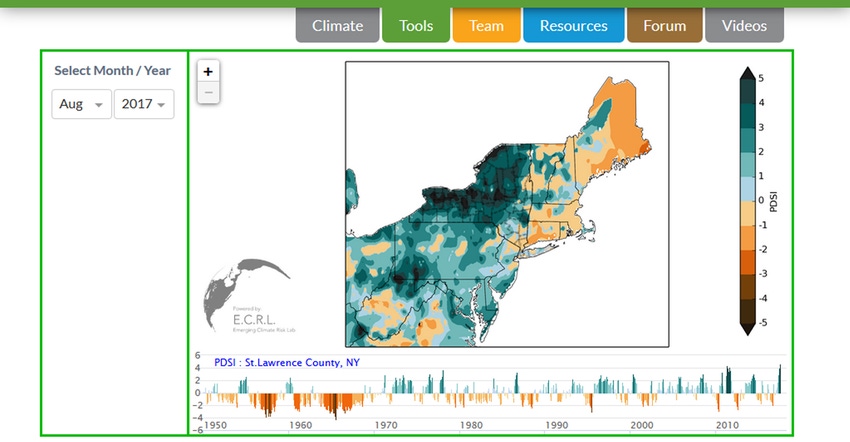
Weather risk concerns have never been greater, as evidenced by Hurricane Harvey’s devastation. That’s why smart farmers are tapping into web-based tools to minimize risks and capitalize on potential market opportunities.
Cornell’s Climate Smart Farming program has added a fifth online tool to help farmers adapt to ever-changing climate. The New York State/Northeast Drought Atlas presents drought severity state-by-state, county-by-county (New York only), for the entire region. It’s more localized than the federal U.S. Drought Monitor. While the national monitor is updated weekly, the Northeast atlas maps are updated monthly, with an online newsletter for users.
“Climate extremes are becoming more acute — certainly affecting farmers,” says Allison Chatrchyan, director of the Cornell Institute for Climate Smart Solutions. “In 2016, a large portion of the Northeast saw drought conditions for the entire growing season. Farmers sustained losses on all kinds of crops. After the drought, farmers told us they need more accurate, real-time information on how the climate is changing in their specific location.
“This year, we’ve had huge amounts of rain,” she adds. “Farmers are seeing extremes — and they are beginning to connect it to the bigger issue of a shifting climate. Now, we finally have more tools to help them reduce their risks.”
What is in the toolbox
The application joins Climate Smart Farming’s toolbox: Apple Stage/Freeze Damage Probability, the Grape Hardiness and Freeze Risk, the Water Deficit Calculator and the Growing Degree Day Calculator. That online toolbox also offers links to a host of risk management information on drought, flooding, frost, heat stress and more.
All the tools are free and can help you make more informed decisions about many agricultural practices. “Our goal is to have easy access to a repository of online decision tools,” adds Jonathan Lambert, former CICSS program manager. The atlas includes a free, quarterly newsletter. March’s newsletter predicted drought conditions would end this summer. July’s newsletter suggested that wet conditions would likely last through September.
The apple freeze, grape hardiness and growing degree day applications are being used by Extension specialists and farmers. Last spring, farmers tested the apple freeze risk application when temperatures dipped far below freezing. Producers used the water deficit calculator, which came online late last summer, to grapple with drought.
At a recent regional conference for organic growers, one farmer reported using the growing degree day application, coupled with Integrated Pest Management strategies and the Network for Enviro and Weather Application to track pests — identifying specific growing degree days needed for certain insects to develop and mature.
Cornell Extension Agronomist Kitty O’Neil notes that these tools provide critical information that previously was not available due to the lack of sufficient weather stations in the region. “These online instruments are great tools. They’re used frequently to inform and guide our area farmers, who are the front line in confronting climate change.”
The Climate Smart Farming website features other online resources. Adapt-N, for instance, allows farmers to precisely apply nitrogen to corn. The COMET-Farm application, developed by Colorado State University and the U.S. Department of Agriculture, estimates and evaluates a farm’s carbon footprint, with an eye toward reducing greenhouse gas emissions.
About the Author(s)
You May Also Like




